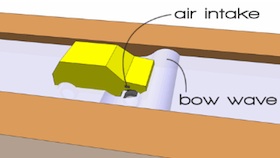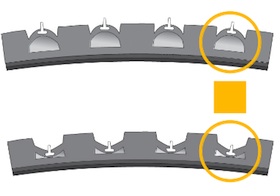Concept showcases Terrain Response, Wade Aid, Driveline Disconnect and torque vectoring.
Land Rover was kind enough to invite "Exhaust Notes" to the beach in Malibu, Calif., before the Los Angeles Auto Show to drive the new Defender concept. The beautiful day saw us hop into the concept and tool around the beach -- slowly and carefully, because it's still basically a bolted-together show vehicle -- until the lifeguards kicked us off. The concept was in North America to introduce a new-look Defender to the States and showcase some exciting technologies in the pipeline. The redesigned global model will arrive around 2015.After the concept test drive we checked out the various Terrain Response systems in the Range Rover Evoque, which you choose based on road conditions -- highway, sand or snow. Going forward, Land Rover plans to have the car know the terrain ahead and adjust suspension, throttle response and power distribution through a variety of sensors. Using high-definition video cameras mounted on the side-view mirrors, front-mounted sensors to detect road variations and a probability matrix that takes into account wheel, suspension and body information, the goal is to have future vehicles auto-select the appropriate Terrain Response setting. Land Rover is already known for conquering seemingly impossible off-road conditions, but the idea going forward is seamless driving performance from the highway to off-road in any conditions -- including wading on beaches or in rivers.
Speaking of wading: The new Wade Aid technology uses sonar sensors to help guide drivers even when they can’t see the road ahead -- say, traversing a muddy river while on safari. The system reads the bounced-back sonar signals to determine water depth ahead of the vehicle, then advises the driver on the safest speed, closes vehicle vents if necessary and raises the ride height. The next wave of research is focused on turning the bow wave to an advantage: By adjusting speed accordingly, the system could help the driver keep the wave’s trough as low as possible, keeping the air intake above water when normally it would be submerged. You potentially could traverse water that technically would be too deep, as long as you followed the wave's crest at the ideal speed.
How about bringing some James Bond technology to reality? "Die Another Day" fans will remember when Bond is driving his Aston Martin through the ice palace and the car becomes invisible, then drives up the wall. No, we're not talking the invisibility shield, but rather the actuating spike tires. Land Rover’s patented On-Demand Spiked Tyres aren’t that far away; the company even has a working prototype. Small chambers between the treads have studs that extend when the chamber is pressurized via electronic sensor. Voila: instant studded tires for climbing sheets of ice (OK, the horizontal kind). They are just as easily be retracted via the same electronic sensor.
If that’s not enough, Land Rover also has torque vectoring and Driveline Disconnect to keep the Defender on all fours. With torque vectoring, power will be distributed to outside wheels during the beginning of a turn, switching to the inside wheels during the turn exit for more control and stability during turning, off-road and on. With Driveline Disconnect, the Defender will be able to switch from 2-wheel drive to four. Nothing new, you say? This isn’t some electronic bypass but a mechanical disconnection of the rear axle from the center differential, which Land Rover says will result in a 7 percent fuel savings during highway driving. And when the highway is getting a little too boring and you want to take the shortcut that only you know about, the 4-wheel drive can recouple just as fast as those using an electronic system.
The iconically spartan Defender is headed back to the U.S., but this time it will pack some high-tech goodies -- and we say that's a welcome addition.
Source: Exhaust Notes MSN




ReplyDeleteشركة تنظيف بمحايل عسير
شركة تنظيف خزانات بمحايل عسير
شركة مكافحة حشرات بمحايل عسير
نقل عفش الفروانيه
ReplyDeleteنقل عفش الاحمدي
نقل عفش الكويت
شركة نقل عفش حولي